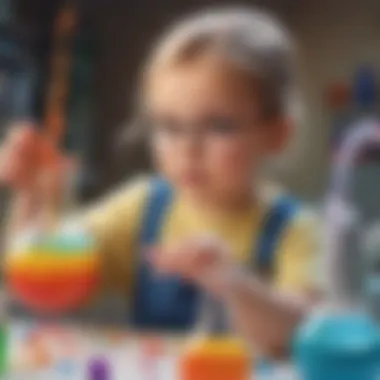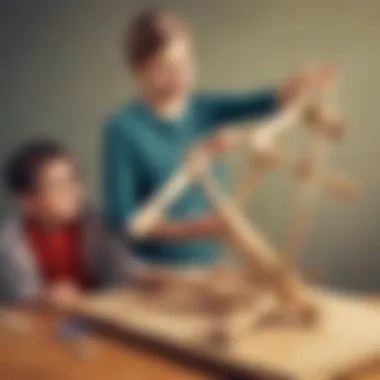Engaging Science Experiments for Young Learners


Intro
Engaging young minds in science can be a transformative experience. Experiments ignite curiosity and foster a sense of exploration in children. This article will delve into effective science experiments designed specifically for young learners. The focus will be on activities that not only captivate but also enhance critical thinking and problem-solving skills. Parents, teachers, and caregivers will gain insights into various experiments, their educational significance, and how to prepare for a successful experience.
Science Fun Facts
Understanding science is not just about experiments; it’s also about discovering the fascinating traits of the natural world. Here are some interesting trivia and facts that can inspire young scientists:
- Honey Never Spoils: Archaeologists have found pots of honey in ancient Egyptian tombs that are over 3,000 years old and still edible.
- Water Expands When Frozen: Unlike most substances, water expands when it freezes, which is why ice floats.
- Bananas are Berries: Botanically, bananas belong to the berry family, while strawberries do not.
Interesting facts like these can spark questions and lead to experiments that explore the science behind them.
Quirky Science Stories
Science history is filled with quirky stories that can engage children’s imaginations. One such story is about an accidental discovery. Alexander Fleming discovered penicillin when he noticed that a petri dish had developed mold. Instead of throwing it away, he observed that the bacteria surrounding the mold were being killed. This serendipitous finding changed medicine forever and exemplifies how being curious and observant can lead to significant breakthroughs.
Amazing Science Records
Science is full of remarkable records that can inspire kids to think big. For example, the tallest known mountain in the solar system is Olympus Mons on Mars, standing about 13.6 miles tall. On Earth, the fastest animal is the peregrine falcon, which can dive at speeds over 200 miles per hour. These records can introduce children to concepts of measurement, biology, and planetary science.
Thought-Provoking Questions
Asking questions is essential for scientific thinking. Here are some questions that can lead to exploration:
- Why do we see colors differently?
- What makes things float or sink?
- How do plants know when to grow?
Encouraging children to think about such questions can lay the groundwork for thoughtful experiments.
Discover the Wonders of Science
To make science engaging, it is essential to present various scientific concepts through interactive and relatable means.
Exploring Various Scientific Concepts
Science is not limited to a single field. It encompasses physics, chemistry, biology, and earth science. Each concept can be broken down into simplistic terms for young learners. For example, gravity can be taught by dropping different objects and discussing why they fall.
Educational Videos and Animations
Utilizing visual media can enhance understanding. Websites like BBC Bitesize offer educational videos on a wide range of science topics. These resources can help children visualize complex ideas in an entertaining way.
Interactive Learning Tools
Hands-on tools, such as science kits from Scientific Explorer, provide exciting ways to explore scientific principles. Using these tools, children can create their own experiments at home under guidance.
Real-Life Applications of Science
Real-world applications help solidify concepts learned. Children can relate experiments to everyday situations, like baking. Cooking uses chemistry to combine ingredients, making it a fun and practical application of science.
Science Quiz Time
Quizzes can be an effective way to reinforce learning while keeping it light and engaging.
Interactive Quizzes
Using platforms like Kahoot! can make it easy to create quizzes that assess what the children learned during experiments.
Multiple Choice Questions
Sample questions might include:
- What is the boiling point of water?
- Which gas do plants need for photosynthesis?
Children can reflect on their knowledge while enjoying themselves.
Brain Teasers and Puzzles
Encouraging logical thinking can be done through puzzles related to science. For example, ask children to arrange planets in order from the sun and explain why.
Science Experiment Showcase
Experiments are the heart of scientific inquiry. This section will provide a few examples that can be done at home.
Fun and Engaging Experiments
One simple yet engaging experiment is the classic baking soda and vinegar volcano. It teaches children about chemical reactions and is visually exciting.
Step-by-Step Instructions
- Gather materials: baking soda, vinegar, food coloring, and a container.
- Pour two tablespoons of baking soda into the container.
- In a separate cup, mix vinegar with food coloring.
- Pour the vinegar mixture into the container with baking soda.
- Observe the reaction as it bubbles and overflows like a volcano!


Materials List
- Baking soda
- Vinegar
- Food coloring
- Container
Safety Tips and Precautions
Always wear safety goggles and conduct experiments in a well-ventilated area. Ensure children understand safety rules before starting.
Engaging young minds with science experiments can inspire the next generation's innovators and problem-solvers.
Understanding the Importance of Science Experiments
Science experiments hold paramount significance in the educational journey of young learners. Engaging in hands-on activities helps them grasp complex concepts in a relatable manner. Through experiments, children develop critical skills like observation, analysis, and reasoning, fostering a deeper understanding of the natural world.
Experiments provide a foundation for practical learning. They move beyond theoretical knowledge, allowing children to see scientific principles in action. This engagement not only enhances cognitive skills but also aids in retaining information more effectively. Furthermore, experiments encourage children to ask questions, form hypotheses, and seek answers through exploration. This inquisitive mindset is essential for developing lifelong learners.
The Role of Experiments in Learning
Experiments serve as a bridge between abstract ideas and practical understanding. When children participate in experiments, they are not just passive recipients of information. Instead, they become active learners, experimenting with variables and seeing firsthand how these variables interact in a controlled environment. Such experiences are crucial in developing a scientific mindset.
Moreover, experimentation promotes the ability to work collaboratively. Many experiments require teamwork, teaching children how to communicate effectively and share responsibilities. Learning in a collaborative setting mirrors real-world scientific environments, preparing them for future endeavors.
Promoting Curiosity and Exploration
Science experiments inherently stimulate curiosity. They invite children to explore the unknown and encourage them to engage with their surroundings. Each experiment unveils new questions, urging learners to dig deeper and investigate further. This cultivation of curiosity is vital in fostering an innovative spirit among young minds.
By allowing children to design their own experiments or modify existing ones, adults can enhance their exploratory skills. Young scientists learn that failure is a part of the scientific process, reinforcing perseverance and problem-solving abilities. As they navigate through challenges in experiments, they build resilience and gain confidence in their capabilities.
"Curiosity is the engine of achievement." - Ken Robinson
Selecting Appropriate Experiments
Choosing the right experiments is crucial in fostering an effective learning experience for young minds. Selecting appropriate activities not only stimulates curiosity but also lays the groundwork for critical thinking skills. Each experiment should match the learner's capabilities and interests, ensuring that the process is enjoyable and educational.
Factors to Consider
Age Appropriateness
Age appropriateness is essential when selecting science experiments. Young learners between six to twelve years old have diverse cognitive abilities and interests. The right experiment should match their developmental stage to enhance understanding and engagement. For younger children, simple, hands-on activities are ideal. These can include projects like making a volcano or observing plant growth. Such activities are attractive because they connect directly to their everyday experiences.
A unique feature of age appropriateness is its adaptability. It ensures that challenging concepts do not overwhelm children, but rather invite them to explore. However, one must also be cautious. Overly simplified experiments can fail to hold their attention, leading to disengagement and missed learning opportunities.
Complexity and Duration
Complexity and duration are also significant elements in selecting experiments. A well-crafted experiment should neither be too complex that it frustrates young learners, nor so simple that it fails to engage their minds. Ideal experiments strike a balance, allowing some level of challenge, while also being clear in what is expected.
Experiments that are too lengthy, like long-term plant growth studies, can test the patience of younger children. Shorter activities, like a quick chemical reaction with baking soda and vinegar, maintain excitement and interest. The ideal complexity enhances problem-solving skills, while appropriate duration keeps learners involved without fatigue.
Safety Considerations
Safety considerations cannot be overlooked when conducting experiments with young learners. Understanding and identifying hazards is crucial. Potential risks need to be mitigated before starting any activity. For instance, if using materials like vinegar and baking soda, ensure children know not to ingest any substances and understand proper handling techniques.
A key characteristic of safety measures is the necessity for supervision. Caregivers should always be present to guide young scientists through the process. This oversight not only protects against accidents but also enriches the learning experience. However, improper safety practices can lead to mishaps that may discourage future exploration with science.
Aligning with Educational Goals
Aligning science experiments with educational goals ensures that the activities support broader learning outcomes. It means considering what concepts or skills are being developed alongside scientific knowledge. For example, experiments can be designed to incorporate lessons in biology, chemistry, or even math through measurement and data analysis. This alignment helps reinforce learning across different subjects, making knowledge more cohesive and integrated.
By thoughtfully selecting experiments, caregivers and educators can provide a rich learning environment that captivates and nurtures young minds. Each element from age appropriateness to safety measures plays a role in ensuring a rewarding experience.
Categories of Science Experiments
Understanding different categories of science experiments is vital in guiding young learners. Each category offers unique opportunities for exploration and learning. Combining various scientific fields can enrich children's understanding of the world around them. These experiences help cultivate essential skills such as observation, critical thinking, and problem-solving.
Physical Science Experiments
Physical science experiments focus on concepts like motion, energy, and matter. These experiments allow children to observe physical phenomena directly. They also illustrate fundamental laws of physics in a tangible way. For example, a simple experiment can involve using a pendulum to demonstrate the effects of gravity. Through this hands-on approach, young minds gain insight into principles that govern their everyday lives.
Chemical Reactions
Chemical reactions reveal how substances interact. They can ignite interest in how materials transform through various processes.
Simple Chemical Reactions
Simple chemical reactions involve easily observable changes. These activities often require common household items. For instance, combining baking soda and vinegar creates a visible effervescent reaction. Such experiments engage children as they witness reactions first-hand. They demonstrate key characteristics of reactive processes while being safe and accessible. This simplicity makes them a popular choice.
Observing Changes
Observing changes is a crucial aspect of understanding chemical reactions. Children can learn about states of matter and how substances can change form. For example, melting ice or boiling water showcases how temperature affects material states. This aspect lends itself well to discussions about physical and chemical properties. It is beneficial for reinforcing concepts like conservation of mass and energy changes during reactions.


Biological Experiments
Biological experiments enable learners to explore life sciences, offering insights into living organisms. By experimenting with plants or small animals, children understand fundamental biological processes.
Plant Growth Experiments
Plant growth experiments explore the essential needs for plant life, such as sunlight and water. By observing growth over time, children enhance their observational skills. This activity connects them with nature and teaches patience. They learn to make connections between different variables, like how different types of soil or light affect growth.
Simple Animal Studies
Simple animal studies can provide insights into basic animal behaviors and habitats. For example, observing ants can teach children about ecosystems and teamwork in nature. Such studies help develop an appreciation for living creatures and the environment. They also foster ethical considerations in observing nature.
Earth and Space Science Experiments
Earth and space science experiments engage with planetary systems, weather phenomena, and geological activities. These experiments can be awe-inspiring and educational. For example, creating a small model volcano can stimulate discussions around volcanology or geology. Young learners become curious about their environment, prompting further inquiry into earth sciences.
Conducting Science Experiments Effectively
To gain the most from science experiments, it is vital to conduct them effectively. This step ensures that young learners can assimilate the knowledge gained, build critical thinking skills, and appreciate the scientific process. Effective conduction of science experiments involves three crucial elements: preparation, following procedures, and encouraging critical thinking.
Preparing for the Experiment
Gathering Materials
Gathering materials for a science experiment is a foundational step that ensures a successful execution. The characteristic aspect of gathering materials is the requirement for specific items that will facilitate the experiment. It is beneficial because it organizes the learning process and reduces disruption during the activity. Materials can range from simple household items like vinegar and baking soda for a basic volcanic reaction to more complex tools for biological studies.
- Unique Feature: The unique aspect of this step is that it can serve as a learning opportunity itself. Children can learn to identify and source materials, enhancing their practical skills.
- Advantages and Disadvantages: While gathering materials can be fun, it may also lead to challenges if certain items are difficult to find. Parents and caregivers should ideally prepare in advance to ensure everything is ready for the experiment.
Setting Up a Safe Workspace
Creating a safe workspace is essential for conducting science experiments effectively. A safe workspace minimizes the risk of accidents, allowing students to focus more on learning. This arrangement might include using tables that can withstand spills and ensuring proper ventilation, particularly when working with chemicals.
- Key Characteristic: The emphasis on safety positions this step as especially important. Setting up a workspace helps children understand the importance of a controlled environment for conducting experiments.
- Unique Feature: Developing a safe workspace can empower young minds to take ownership of their learning. By involving them in setting it up, they learn responsibility.
- Advantages and Disadvantages: The disadvantage could be that a space is not flexible enough for different types of experiments. This limitation can be overcome through adaptable setups that allow for various scientific inquiries.
Following Procedure and Observations
Detailed Instructions
Following detailed instructions is paramount for successful experimentation. This step ensures that students understand how to execute each part of the experiment properly, enhancing their learning outcomes. It prepares them for the structured approach often required in scientific research.
- Key Characteristic: Detailed instructions are crucial as they guide young scientists through unfamiliar processes. Using clear, simple language is beneficial for preventing confusion.
- Unique Feature: This aspect also helps children practice following directions, a skill needful in numerous aspects of life.
- Advantages and Disadvantages: One possible disadvantage is that overly complex instructions might require additional explanation. Keeping them straightforward supports comprehension.
Documenting Results
Documenting results is a key component of any science experiment. Recording observations and outcomes helps reinforce what young learners have experienced. This habit encourages analysis and reflection on the process.
- Key Characteristic: The contribution of documenting results is substantial, as it promotes the practice of maintaining records similar to professional scientists. This method teaches them the value of keeping logs in scientific research.
- Unique Feature: An interesting element is that children can express their findings creatively through drawings or written reports. By being part of this expression, they can feel a greater connection to their work.
- Advantages and Disadvantages: A challenge in this process could be a reluctance from children to write down results. Addressing this with engaging formats can overcome the reluctance and show that documenting can be fun.
Encouraging Critical Thinking
Formulating Hypotheses
Formulating hypotheses sharpens critical thinking in young scientists. It encourages them to make predictions based on prior knowledge, enhancing their reasoning skills. This step fosters a scientific mindset by promoting inquiry.
- Key Characteristic: The ability to hypothesize is important as it invites a level of engagement, making students active participants in their learning.
- Unique Feature: Formulating hypotheses can be a fun brainstorming exercise, allowing children to express their ideas openly without judgment.
- Advantages and Disadvantages: A disadvantage is that if the hypothesis appears too far-fetched, it could discourage children. Celebrating all ideas as valid encourages a creative environment where thinking outside the box is welcomed.
Analyzing Outcomes
Finally, analyzing outcomes closes the loop of the scientific method. It allows students to evaluate their initial hypotheses in light of the actual results. This reflection integrates learning and creates a deeper understanding of scientific principles.
- Key Characteristic: The key benefit is that it enhances analytical thinking. Children learn to look critically at data, fostering a mindset that values evidence-based conclusions.
- Unique Feature: Analyzing outcomes can also inspire discussions about possible improvements in the experimental process or further questions, fostering a love for continuous inquiry.
- Advantages and Disadvantages: One challenge could be that children may struggle with understanding complex results. Providing supportive structures and group discussions can help consolidate their learning.
Overall, conducting science experiments effectively requires careful thought and planning at every stage. By preparing properly, following instructions diligently, and fostering critical thought, young minds can truly benefit from the wonders of science.
Integrating Technology in Experiments
Integrating technology within science experiments is becoming increasingly essential in today’s educational landscape. It opens up new avenues for young minds to engage with scientific concepts in a more interactive and effective manner. By leveraging technology, educators and parents can enhance the learning experience, making it more appealing and relevant. This section will explore the specific elements and benefits of incorporating technology, along with considerations for implementing it in science activities.
Using Digital Tools for Data Collection
Digital tools offer innovative ways for children to collect and analyze data during experiments. For instance, using tablets or smartphones enables young explorers to record their findings efficiently and accurately. Applications that are designed for scientific inquiry can assist in graphing results effortlessly. Moreover, technology such as sensors and probes can enhance measurement accuracy.
- Benefits:
- Accuracy: Digital tools minimize human error in measurements.
- Engagement: Interactive features keep children motivated and interested.
- Visualization: Graphing software helps visualize trends and patterns quickly.
To facilitate data collection, teachers and caregivers should select appropriate tools. Choosing age-appropriate apps is crucial for ensuring the children understand the software and are able to utilize it effectively.
Educational Apps and Platforms


Various educational apps and platforms serve as excellent resources for conducting science experiments. These platforms provide tutorials, video demonstrations, and interactive challenges tailored for young learners. Some notable educational apps include Tinkercad, which helps kids design and simulate circuits, and Labster, which offers virtual lab environments.
- Considerations for Choosing Apps:
- User-Friendly Interface: The app should be intuitive for children.
- Age Appropriateness: Content must match the comprehension level of the intended age group.
- Educational Value: The app should offer insights into scientific concepts and theories.
Using technology in science experiments provides a hands-on approach that not only fosters curiosity but also prepares young minds for a tech-savvy future.
Safety Protocols for Young Scientists
Safety protocols are critical to conducting science experiments, especially for young minds. When children engage in hands-on activities, ensuring their safety becomes paramount. These protocols not only protect young scientists from potential hazards but also instill a sense of responsibility and awareness about safety in general. By implementing these measures, adult supervisors can foster an environment that encourages exploration while minimizing risks.
Identifying Hazards
Recognizing hazards is the first step in ensuring safety during science experiments. Various elements can pose risks, from chemical substances to physical instruments. Parents and educators should thoroughly assess materials before an experiment begins. Common hazards might include sharp objects, toxic chemicals, or even simple items that can cause tripping or falling.
Taking time to identify these potential dangers helps in planning how to manage them effectively. It creates an opportunity for children to learn about their environment.
Basic Safety Measures
To ensure a safe experience for young scientists, basic safety measures should be put in place. These measures include managing the workspace, proper usage of equipment, and making safety gear accessible. Here are the two essential dimensions of safety measures:
Using Protective Gear
Using protective gear is an essential aspect of safety in science experiments. Items such as goggles and gloves play a significant role in protecting young minds from various hazards. Goggles shield the eyes from splashes or flying debris, while gloves can prevent skin contact with unwanted substances. The key characteristic of protective gear is that it creates a barrier between the scientist and potential dangers. This practice becomes a beneficial choice in activities involving chemicals or physical apparatus.
For example, educational kits often emphasize wearing goggles during chemical reactions. The unique feature of this approach is that it not only protects children but also makes them more aware of safety practices. The advantages of using protective gear far outweigh any disadvantages, as compliance with safety protocols often encourages responsible exploration.
Supervision Guidelines
Supervision guidelines are essential in promoting a safe learning environment. These guidelines involve adult oversight during experiments, ensuring kids follow procedures and maintain safety standards. The key characteristic of supervision is continuous monitoring, which is critical for young learners. This vigilance helps in addressing safety issues immediately, reducing the risk of accidents or misunderstandings.
A unique feature of effective supervision is the ability to guide children in making informed decisions about safety. For instance, adults can explain why certain equipment should be handled carefully or demonstrate how to use materials properly. The advantages of adhering to supervision guidelines are significant; they provide an extra layer of protection and foster a collaborative atmosphere where children feel secure while exploring.
Adopting proper safety protocols enhances the overall experience of scientific exploration, providing peace of mind to both children and their supervisors.
Though safety cannot be overlooked, it does not need to hinder the excitement of experiments. A careful balance between exploration and safety allows young scientists to thrive in a safe learning environment.
Reflecting on Experiment Outcomes
Reflecting on experiment outcomes is an essential phase in the science learning process for young minds. It encourages children to analyze their experiences and draw conclusions based on their observations. The importance of this reflection lies in fostering critical thinking skills, which are crucial for education and personal development. Engaging in this reflective practice also allows children to understand the scientific method more deeply. Through discussing their findings and exploring the meaning behind them, children not only solidify their knowledge but also enhance their ability to communicate ideas effectively.
Discussing Findings
When children discuss their findings after an experiment, they engage in a collaborative learning process that can be very beneficial. This discussion can take many forms, from informal conversations with peers to structured presentations. The key is to create an environment where children feel safe to express their thoughts and insights.
Benefits of Discussing Findings:
- Enhances Communication Skills: By articulating their results, children improve their vocabulary and ability to convey complex ideas simply.
- Fosters a Sense of Ownership: Children begin to feel a sense of responsibility for their learning when sharing their discoveries.
- Encourages Diverse Perspectives: Hearing different viewpoints can change how they see their results and inspire new ideas.
The discussion can be guided with questions such as:
- What did you expect to happen?
- What actually happened?
- Why do you think there were discrepancies, if any?
- How can we apply this knowledge to other situations or experiments?
"Encouraging children to think critically about their findings helps them develop analytical skills that are valuable in all areas of life."
Encouraging Further Inquiry
Encouraging further inquiry is another important aspect of reflecting on experiment outcomes. This should not be a one-time process. Instead, it should lead to more questions and explorations. Inquiry allows children to extend their learning beyond the initial experiment, deepening their understanding of scientific concepts.
How can this be achieved? Here are some strategies:
- Ask Open-Ended Questions: Questions like "What if?" or "How might we?" can stimulate curiosity.
- Connect to Real-World Applications: Relating findings to everyday life can make science more relevant and exciting.
- Promote Experimentation: Encourage children to design their own experiments based on their newfound questions.
This continuous cycle of inquiry not only embeds critical thinking into young minds but also cultivates a lifelong love of learning and exploration.
Resources for Continued Exploration
In science education, providing young learners with access to various resources enhances their understanding and engages their inherent curiosity. This section highlights the importance of having resources that cater to different learning styles and interests, ensuring that children not only participate in experiments but also grasp the underlying concepts and principles of science.
These resources include books, educational materials, and online platforms that can provide valuable information, supplementary activities, and a sense of community among young scientists and their mentors. Exposure to diverse resources can deepen knowledge and encourage ongoing exploration beyond the classroom or home experiments.
Books and Educational Materials
Books are an essential resource in building a strong foundation in science. They offer structured information in a format that is accessible to young minds. Familiar titles such as "National Geographic Little Kids First Big Book of Science" provide colorful illustrations and simple explanations that cater to elementary school students. Not only do these books introduce vital concepts, but they also spark interest by relating science to everyday life.
Furthermore, educators and parents should consider incorporating activity books that promote hands-on learning. Titles like "Science Play: 65 Cute Activities for Year-Round Fun" engage children in experiments that require minimal materials, making them perfect for home or classroom settings. These activities emphasize inquiry-based learning, allowing children to formulate their questions and explore answers through practical experience.
Online Resources and Communities
The internet is a treasure trove of knowledge, especially for young learners looking to expand their scientific horizons. Websites such as Wikipedia provide easy access to articles explaining scientific concepts. Sites like Britannica offer age-appropriate explanations and serve as a reliable source of information. Parents and teachers can encourage children to visit these resources to supplement their learning and gather information for their projects.
Online communities, such as Reddit, feature groups like r/EducationalGems, where educators and parents share effective experimentation ideas and answer common questions. These platforms allow for the exchange of resources and strategies that can enhance the learning experience. Joining these communities promotes collaboration and encourages young learners to take initiative in their educational journeys.
"Access to a variety of resources is crucial in shaping young scientists. The more exposure they have, the more skills they develop."
In summary, having an array of resources allows young minds to explore, understand, and engage with science in an effective way. Books and online platforms create an environment where learning continues outside of formal education settings, fostering a lifelong love for discovery.







